Botanical collection

Aquatic plant gardens
The aquatic plant gardens are another unusual element within a park.
Here the Dutch designer used another of her contrasts, creating a lake with very marked architectural forms that has all the characteristics of a natural lake, thanks to the use of different types of aquatic plants. This type of plant differs in fact by categories depending on the form in which it is present in water, free or anchored to the ground, and depending on the depth in which it proliferates and colonizes.
The construction of the bio-lake has therefore moved from a first selection that concerned rather simple plant forms, where the flowering and colour component are secondary to the affinity of reproduction of a natural environment. Similarly, the choice of species has thus covered the different biological forms found in ponds. The environment thus recreated should also encourage the arrival of all those forms of animal life that habitually frequent these habitats and, although it is certainly an urban park, we have already seen the first dragonflies!
n° of plants: 450
ELENCO SPECIE
Aquatic plants:
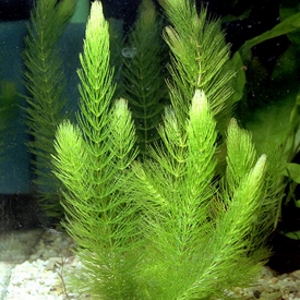 Ceratophyllum demersum Fast-growing underwater plant. Lavishly used in ponds as well as aquariums as it contributes toward effectively slowing down the development of algae, oxygenating the water and absorbing the organic substances dissolved in it. It prefers exposure to sunlight or half-shade.
Ceratophyllum demersum Fast-growing underwater plant. Lavishly used in ponds as well as aquariums as it contributes toward effectively slowing down the development of algae, oxygenating the water and absorbing the organic substances dissolved in it. It prefers exposure to sunlight or half-shade.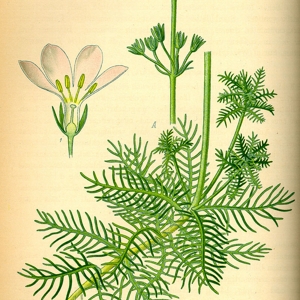 Hottonia palustris Also known as Water violet, it has an upright stalk, with submerged leaves and roots. Its small, white flowers with a yellow centre emerge from the water on stems about 20-30 cm long. It usually lives in stagnant fresh water of varying size, such as edges of small lakes, ponds, river bends and ditches.
Hottonia palustris Also known as Water violet, it has an upright stalk, with submerged leaves and roots. Its small, white flowers with a yellow centre emerge from the water on stems about 20-30 cm long. It usually lives in stagnant fresh water of varying size, such as edges of small lakes, ponds, river bends and ditches.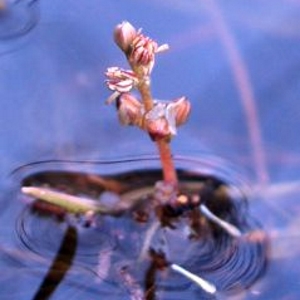 Myriophyllum alterniflorum Underwater herbaceous plant typical of both stagnant and flowing waters, including rapidly flowing rivers, consisting of thin underwater stalks covered with small and delicate green leaves forming dense coverage. Its small flowerets appear when they emerge from the surface of the water.
Myriophyllum alterniflorum Underwater herbaceous plant typical of both stagnant and flowing waters, including rapidly flowing rivers, consisting of thin underwater stalks covered with small and delicate green leaves forming dense coverage. Its small flowerets appear when they emerge from the surface of the water.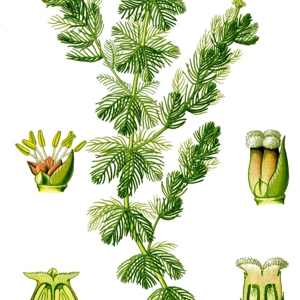 Myriophyllum spicatum Known as Eurasian watermilfoil, it has leaves divided into segments and a colour varying from brown to green, depending on the light and the season. During the summer, characteristic red spadix inflorescences appear. A useful underwater oxygenating plant, it is able to slow down the propagation of algae.
Myriophyllum spicatum Known as Eurasian watermilfoil, it has leaves divided into segments and a colour varying from brown to green, depending on the light and the season. During the summer, characteristic red spadix inflorescences appear. A useful underwater oxygenating plant, it is able to slow down the propagation of algae.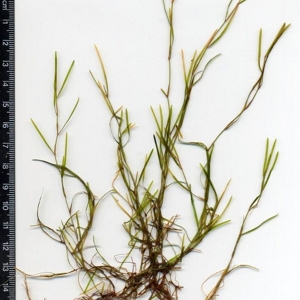 Potamogeton pusillus Perennial herbaceous plant with floating or submerged leaves, it grows in ponds, canals and ditches, in clear water, from sea level to the mountain zone. It features small greenish flowers in spikes during the June to August period.
Potamogeton pusillus Perennial herbaceous plant with floating or submerged leaves, it grows in ponds, canals and ditches, in clear water, from sea level to the mountain zone. It features small greenish flowers in spikes during the June to August period. Ranunculus aquatilis A very rustic plant without any particular requirements that loves shady areas and calm, stagnant water. The small white flowers with a yellow centre develop for a few centimetres above the surface of the water from May to June. It prefers exposure to full sunlight.
Ranunculus aquatilis A very rustic plant without any particular requirements that loves shady areas and calm, stagnant water. The small white flowers with a yellow centre develop for a few centimetres above the surface of the water from May to June. It prefers exposure to full sunlight.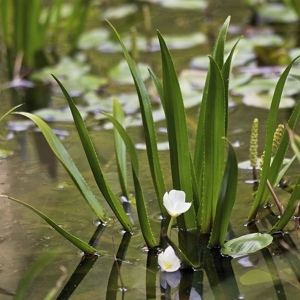 Stratiotes aloides Underwater plant boasting an extraordinary life strategy, it produces a rosette of leaves that in the summer float on the surface of the water, while in the fall they are immersed all the way to the bottom, surviving even cold winters without any problems. Lovely white flowers appear above the surface of the water between July and September.
Stratiotes aloides Underwater plant boasting an extraordinary life strategy, it produces a rosette of leaves that in the summer float on the surface of the water, while in the fall they are immersed all the way to the bottom, surviving even cold winters without any problems. Lovely white flowers appear above the surface of the water between July and September.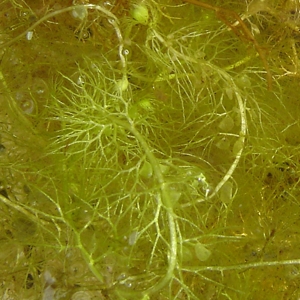 Utricularia vulgaris Z carnivorous plant commonly called bladderwort owing to its unusual structures that act both as floats and as small traps. These structures contain air that when they come into contact with several bristles, they open and are filled with water, sucking in the unwary water organism. It usually grows in shallow, stagnant water, also in shady sites.
Utricularia vulgaris Z carnivorous plant commonly called bladderwort owing to its unusual structures that act both as floats and as small traps. These structures contain air that when they come into contact with several bristles, they open and are filled with water, sucking in the unwary water organism. It usually grows in shallow, stagnant water, also in shady sites.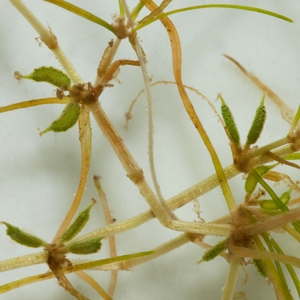 Zannichellia palustris It grows in fresh or brackish, stagnant or slow flowing, clear and cold waters. It is recognisable by its long, thin and thready stalks, leaves and roots. Its seeds have a characteristic horned shape. Small white flowerets appear between April and July.
Zannichellia palustris It grows in fresh or brackish, stagnant or slow flowing, clear and cold waters. It is recognisable by its long, thin and thready stalks, leaves and roots. Its seeds have a characteristic horned shape. Small white flowerets appear between April and July.
Botanical information powered by AG&P



